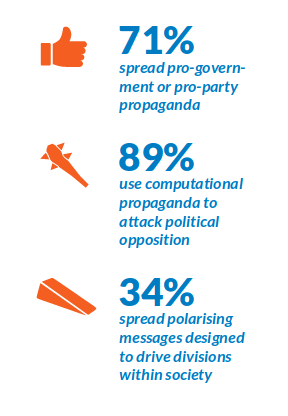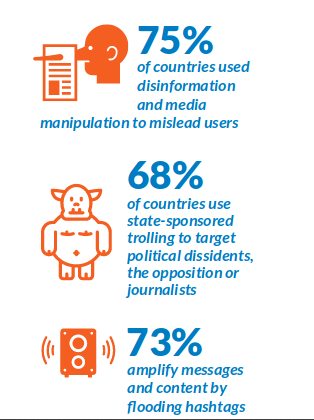Computational propaganda – the use of algorithms, automation, and big data to shape public life – is becoming a pervasive and ubiquitous part of everyday life, the Oxford Computational propaganda research claims. Authorities and political parties worldwide are increasingly using this tool of manipulation and influence to attain favorable voting at elections or suppress opponents in the authoritarian regimes. The use of the tool has more than doubled in the last two years: from 28 targeted countries in 2017 to 70 in 2019. Social media, which was once heralded as a force for freedom and democracy, has degraded to a space for disinformation, inciting violence, and undermining the legitimacy of democratic institutions.

Who orders and who executes computational propaganda?



A business of computational propaganda
Computational propaganda remains a big business. The researchers found large amounts of money being spent on "PR" or strategic communication firms to work on campaigns in countries such as the Philippines, Guatemala, and Syria. The finances involved can reach multi-million-dollar contracts with global companies like Cambridge Analytica. Some teams are comprised of a handful of people who manage hundreds of fake accounts. In other countries – like China, Vietnam, or Venezuela – dozens of thousands of people are hired by the state to actively shape opinions and police speech online. Thus, the skills of computational propaganda attain value and are being disseminated worldwide. For example, during the investigations into cyber troop activity in Myanmar, evidence emerged that military officials were trained by Russian operatives on how to use social media. Similarly, cyber troops in Sri Lanka received formal training in India. Leaked emails also showed evidence of the Information Network Agency in Ethiopia sending staff members to receive formal training in China.Main strategies of computational propaganda

Trolling and the takedown of accounts or posts can happen alongside real-world violence, which can have a deep and chilling effect on the expression of fundamental human rights.
Who is the leader in computational propaganda
It’s hard to name one country, although there is plenty of where the use of computational propaganda is especially wide-spread. Among the most dangerous are authoritarian regimes that suppress not only activism on the internet but any possible alternative of expression or protest. Researchers distinguish minimal, low, medium and high cyber troop capacity, depending on the team-size and budget that a country spends for propaganda goals. High cyber troop capacity involves large numbers of staff and large budgetary expenditures on psychological operations or information warfare. There might also be significant funds spent on research and development, as well as evidence of a multitude of techniques being used. These teams do not only operate during elections but involve full-time staff dedicated to shaping and controlling the information space. The table below lists all countries with the most developed computational propaganda. The vast majority of countries have middle cyber troop capacity which is still considerably high.
Another important criterion of the capacity of the country’s cyber troop is its attempt for foreign or global influence. Facebook and Twitter – that have begun publishing limited information about influence operations on their platforms – have taken action against cyber troops engaged in foreign influence operations in seven countries: China, India, Iran, Pakistan, Russia, Saudi Arabia, and Venezuela.
Although this measure does not capture the extent to which foreign influence operations are taking place, we can confidently begin to build a picture of this highly secretive phenomenon.
The vast majority of countries have middle cyber troop capacity which is still considerably high.
Another important criterion of the capacity of the country’s cyber troop is its attempt for foreign or global influence. Facebook and Twitter – that have begun publishing limited information about influence operations on their platforms – have taken action against cyber troops engaged in foreign influence operations in seven countries: China, India, Iran, Pakistan, Russia, Saudi Arabia, and Venezuela.
Although this measure does not capture the extent to which foreign influence operations are taking place, we can confidently begin to build a picture of this highly secretive phenomenon.
China has become a major player in the global disinformation order. Until the 2019 protests in Hong Kong, most evidence of Chinese computational propaganda occurred on domestic platforms such as Weibo, WeChat, and QQ. But China’s new interest in aggressively using Facebook, Twitter, and YouTube should raise concerns for democracies worldwide. The Chinese government began to employ global social media platforms to paint Hong Kong’s democracy advocates as violent radicals with no popular appeal, yet the growing sophistication and use of global social networking technologies demonstrates how China is also turning to these technologies as a tool of geopolitical power and influence

Read more:
- Moscow has long sought to destroy Slavic languages other than Russian, Zolotaryev says
- The Kremlin on global warming: Connecting the dots, disconnecting the facts
- How Russian propaganda uses scorched-earth tactics
- Portnikov: With Putin, Zelenskyy can speak freely
- Punishment or well-designed institutions: what will eliminate corruption in Ukraine?





